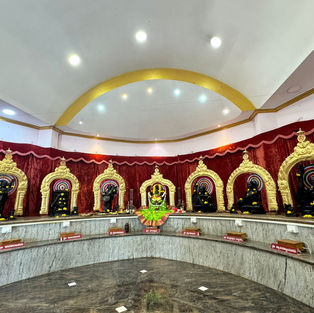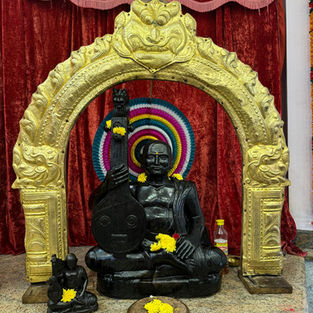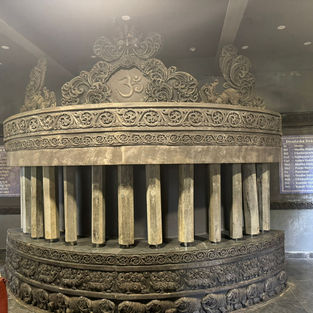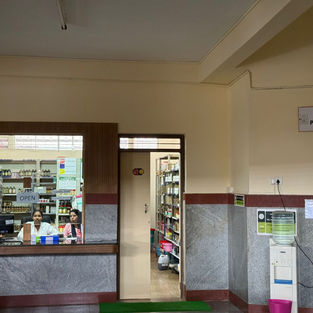Veena Temple - A Lesson on Cultural Humility
Within the first week of our travels, we embarked on a 3-hour journey from Mysore to the rural village of Rudrapatna, which is home to less than 5 thousand people. Despite its size, it had greatly contributed to Karnatika's musical heritage as every family has at least one musician. Children grow up singing, dancing, and playing instruments, and many leave the village as adults to pursue wider recognition, often achieving national or even global fame. To pay back their community, they promote tourism in the form of an international music festival that has been ongoing for 22 years and donations to construct and maintain temples.
Religiously, this village is unique as it holds the Venna temple, which is the first musical temple constructed in Asia and holds seven deities to represent the seven musical notes. It is said that these deities were real people who walked barefoot throughout villages, singing songs to bring about joy and preaching useful wisdom to bring about enlightenment. To enter the temple, you must be barefoot, and to initiate prayer, you must begin with song. The experience was eye-opening, especially due to cultural differences such as utilizing squat toilets and not having any foot protection on asphalt. The most memorable aspect of the trip was the kindness and hospitality of the villagers who attempted conversations and offered food and water despite us being strangers and having limited knowledge of Kannada (their local language). This experience reminded me that although these cultural practices were foreign to me and needed getting used to, it wasn't wrong, as it likely mirrors how Western customs might seem strange to others.
Addressing Health through Ayurveda
During our second week of travels, our trip took on a more health-focused direction, with lectures becoming increasingly specialized and excursions centered around medicine and its related facilities. One of the most memorable experiences involved first listening to an overview of Ayurveda from a doctor, followed by a tour of the JSS Ayurveda Hospital. There, patients are treated and medical students are trained in Ayurveda, which is considered the knowledge and science of life and the art of health and healing. The philosophy centers on the individual, rooted in the belief that everything in the universe exists within the body, and that one must live in harmony with nature to avoid illness caused by internal imbalances.
Students integrated modern science with traditional Ayurvedic methods, studying anatomy, conducting autopsies, cultivating medicinal herbs, and crafting natural remedies. Although the tour was highly informative and offered valuable insight into cultural health practices embraced by many in India, it left me with some skepticism. For example, it was suggested that a wide range of mental illnesses could be treated using oil therapies, such as head and full-body massages involving dripping oil, and neurological disorders could be cured through blood-letting, which are claims that lack strong empirical support (Kulamarva et al., 2023).
As a whole, I do appreciate the Ayurvedic focus on the individual through strengthening the immune system with natural elements, building physical resilience through balance and exercise, and nurturing the mind through meditation and mindfulness. However, I do not think a purely natural approach is sufficient, nor, by that same token, do I agree with the U.S. healthcare system’s tendency to rely heavily on medication as a quick fix, which often neglects a more holistic view of the person and their sustained well-being (Castrucci, 2015; Onolnow, 2024). This tour helped clarify my belief that healthcare should be balanced in prioritizing the individual as a whole, not just in their illness, but in conjunction with incorporating empirically supported treatments and interventions.
Lectures on Global Health and its Silenced Narratives
Throughout the entirety of the trip, daily lectures took place at the Public Health Research Institute of India (PHRII), a women-led research institute which primarily focused on issues related to HPV and the prevention of cervical cancer, the leading cause of death among women in India. Many of our lectures addressed topics such as the symptoms of untreated HPV, diagnosis, patient outreach, public education, and the impact of HPV on the public healthcare system.
Aside from the topic of HPV, we learned other Indian specific cultural practices through lectures on Ayurvedic medicine, yoga, numerology, and cooking classes. Learning how spirituality permeates all aspects of life in India was essential for understanding how to interact respectfully and how religion can significantly influence personal and societal decisions.
However, the most thought-provoking aspect of the program examined the dark underbelly of culture, especially pertaining to the status of women. One lecture particularly discussed the caste system and its ongoing role in perpetuating oppression, where the Brahmins at the top reap rewards and dictate the lives of lower castes (“untouchables”) and Dalits (self-proclaimed discriminated group) remain trapped in poverty with limited life prospects. This ties into another lecture, which discusses the high rate of health risks associated with bidi workers (primarily women who roll cigarettes) who are often confined to this cycle of poverty, as this is the only job they are allowed to have by their husbands (earning only 250 rupees per 1000 bidis). The Dalit movement emphasized that women, regardless of caste, continue to be oppressed, valued mainly in relation to the men around them, and still subject to their control.
These experiences broadened my perspective and revealed cultural nuances I had not previously encountered. As a future neuropsychologist, this experience underscored the importance of thoroughly researching and understanding a client's cultural background, as it can heavily influence how they navigate life and respond to treatment.
References
Castrucci, B. C. (2015). Prevention in the shadows: America’s quick fix culture. De Beaumont Foundation. Retrieved on June 20, 2025, from https://debeaumont.org/news/2015/prevention-in-the-shadows-americas-quick-fix-culture/
Kulamarva, K., Shivakumar, V., Chikkanna, U., Ramakrishna, K. K., Bhargav, H., & Varambally, S. (2023). Role of Ayurveda in the management of psychotic disorders: A systematic review of clinical evidence. Journal of Ayurveda and Integrative Medicine, 14(3), 100720. https://doi.org/10.1016/j.jaim.2023.100720
Olanow, A. (2025). The quick fix epidemic in modern healthcare | Accomplish. Accomplish Health. Retrieved on June 20, 2025, from https://www.accomplish.health/root-cause-medicine-crisis/






































